Setting up a guinea pig cage is crucial in creating a nurturing and enjoyable home for your new pets. But it can also be a fun and rewarding task. The layout of their enclosure and the items you put in it play a key role in enhancing their enrichment and ensuring their comfort. As you organise the space, consider these key aspects:
- Effective Use of Space: Think about how your guinea pigs will use the different areas of the cage. Ensure there’s ample space for all their activities.
- Bedding Choices: Choose bedding for each zone with comfort, absorbency, and maintenance in mind.
- Functional Zoning: Consider dividing the enclosure into specific zones, like eating, sleeping, and exercise areas, to create a structured and engaging environment.
Ease of Cleaning: Arrange the space to make it easy to maintain cleanliness and hygiene. - Safety: Ensure that every aspect of the cage setup is safe and secure to prevent any risks to your guinea pigs.
- Stimulation and Interest: Evaluate the cage’s layout for enrichment opportunities. Features like tunnels, foraging opportunities, and toys can significantly enhance their quality of life.
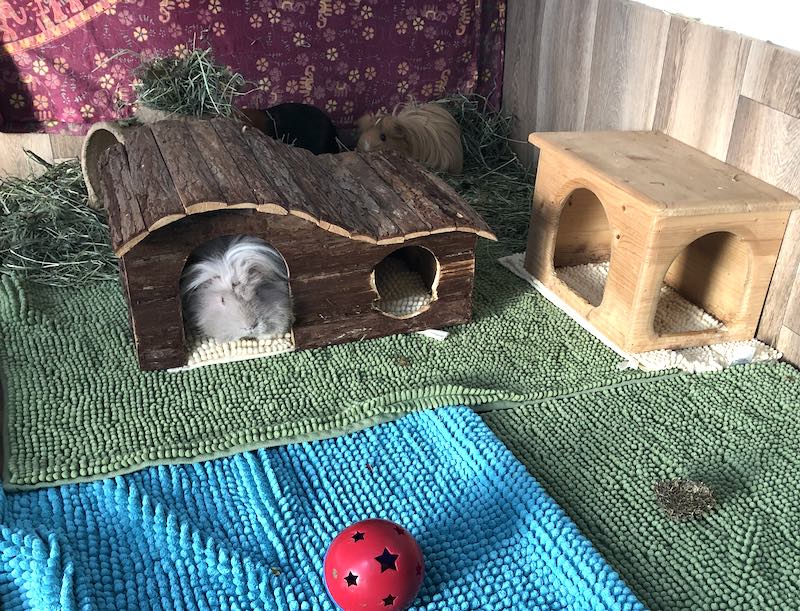
Effective use of space
The size of your guinea pig enclosure greatly influences the layout options available.
In a standard-sized cage, maximising floor space is paramount, so you must strategically place essential accessories while ensuring plenty of space for your guinea pigs to exercise.
You have many more options if you have a larger, supersized enclosure. This extra space allows for a wider variety of accessories and a more creative layout.
However, it’s crucial to maintain a balance in the enclosure with open areas for exercise and quieter spots for rest and hiding to provide a well-rounded environment for your guinea pigs.
Setting up the bedding
Every part of the enclosure requires a layer of bedding, and there are many you can choose from. Please refer to our comprehensive bedding article for detailed information on these options.
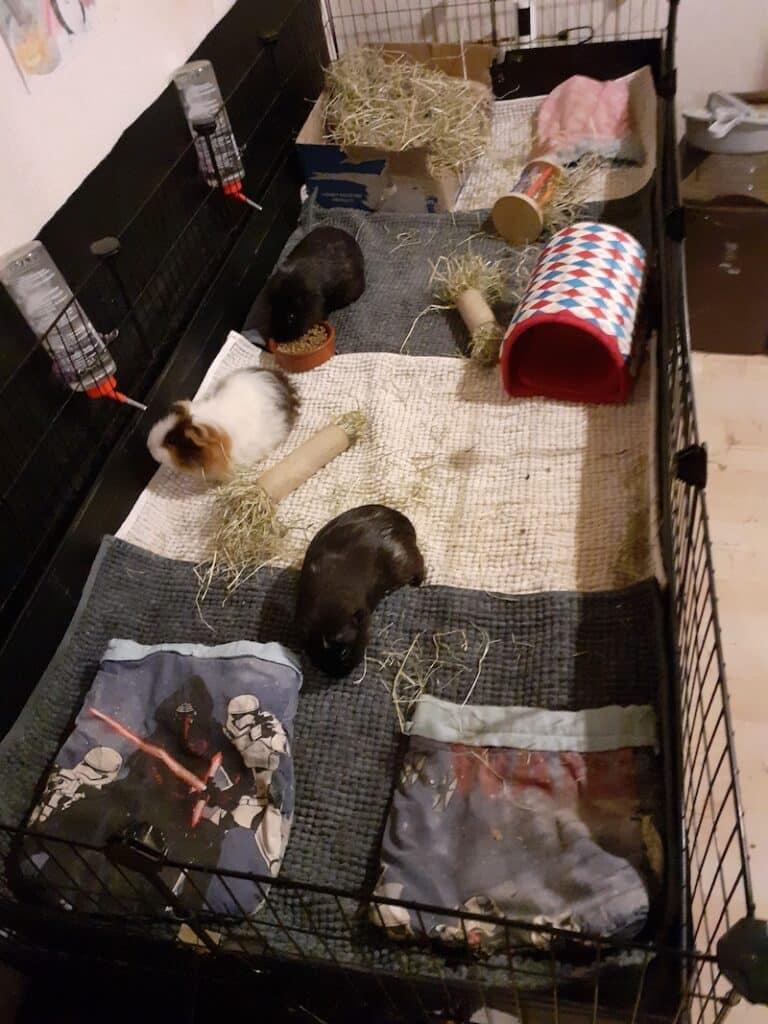
Depending on the zones you’ve established in your enclosure, you might find a combination of washable (e.g. fleece liners or noodle bathmats) and disposable bedding most effective.
In my experience, using washable bedding in the eating area isn’t ideal, as it often needs daily replacement. For specific recommendations on bedding for this zone, please refer to the “Functional Zoning” section below.
Functional zoning
Creating functional zones within your guinea pig enclosure is an effective way to use space and simplify maintenance, regardless of its size.

Eating area
Setting up a specific eating area in your guinea pig cage is a practical approach, mainly because guinea pigs tend to urinate where they eat, especially when consuming hay.
In this designated area, it’s best to use absorbent bedding that is easy to clean and maintain to keep the feeding space hygienic.
Creating a distinct dining section is much easier if you have a large cage. A popular idea is to set up a dedicated feeding area with a large, shallow litter tray full of hay at one end of the cage and a on the wall. This setup keeps the feeding area tidy and makes cleaning much more manageable.
I have designated one end as the dining area in my spacious enclosure, using hideouts to create separate sections.
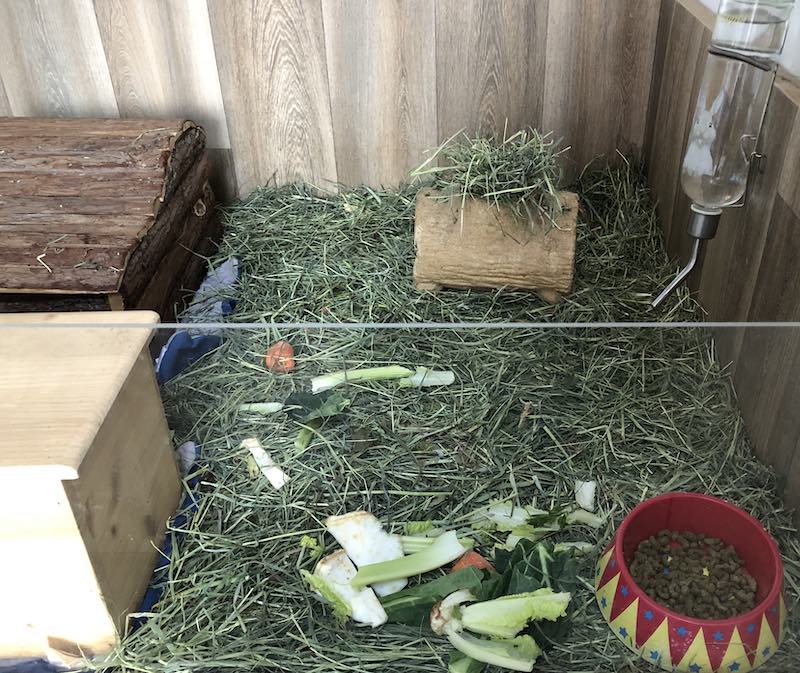
This configuration gives a clear space for hay and fresh food, with easy access for my guinea pigs through spaces between the hideouts. I cover this area with a little disposable bedding, then a good layer of hay for several reasons: my guinea pigs love to lie on it, it encourages natural foraging habits, and more hay provides sufficient absorbency to prevent dampness on the top.
For cleanliness, I add more hay on the second and third days and replace it entirely on the fourth or earlier if necessary. I also have a hay feeder in this area to keep a constant supply of fresh hay available.
Sleeping quarters
Guinea pigs need their individual space, so providing each with a hideout to sleep and feel secure is essential.
For smaller cages
In smaller cages, corner hideouts are ideal for efficiently maximising space. When choosing hideouts, ensure they are appropriately sized – not too large to overcrowd the space, yet spacious enough to ensure your guinea pigs’ comfort.
For larger enclosures
In larger enclosures, you could include one bigger hideout that can accommodate two guinea pigs, allowing them to snuggle together, plus a smaller hideout so they can be on their own whenever they wish.
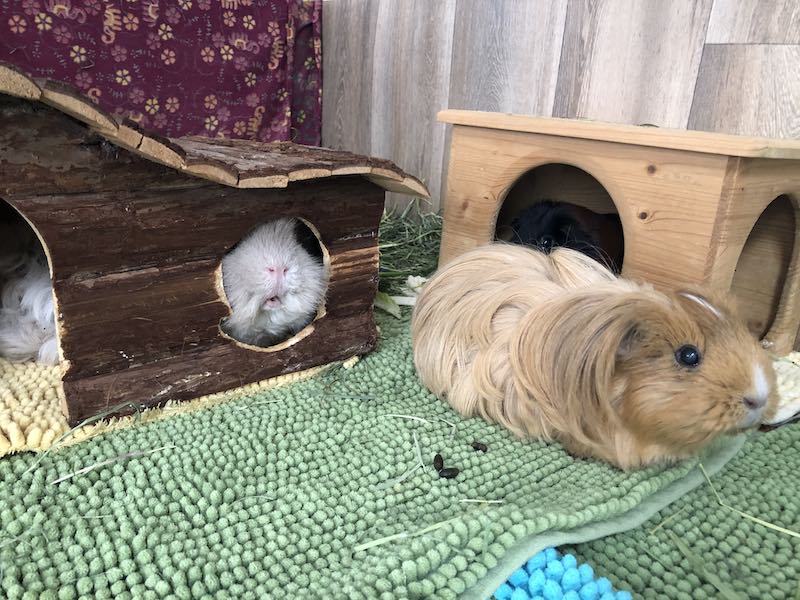
Upper level for resting
If your cage has two storeys, allocating the upper level as the rest area is a good, efficient use of space. Guinea pigs only require a little space for resting, so this setup frees up more area on the ground level for their physical activities.
Hygiene in sleeping areas
Guinea pigs typically choose quiet, dark spots for pooping and urinating, and this means their sleeping areas often need extra attention to hygiene.
Frequent contact with damp bedding can cause urine scalds on a guinea pig’s feet. Therefore, placing extra disposable bedding or washable pee pads inside the hideouts is advisable.
This bedding is easily removable and replaceable, ensuring dryness and cleanliness in these areas.
Exercise areas
In your guinea pig enclosure, it is essential to dedicate a sizable, uninterrupted open area for their exercise zone. As naturally active animals, guinea pigs require ample space to run and play. A long, obstacle-free space is ideal, providing them with the perfect environment to meet their daily exercise needs.
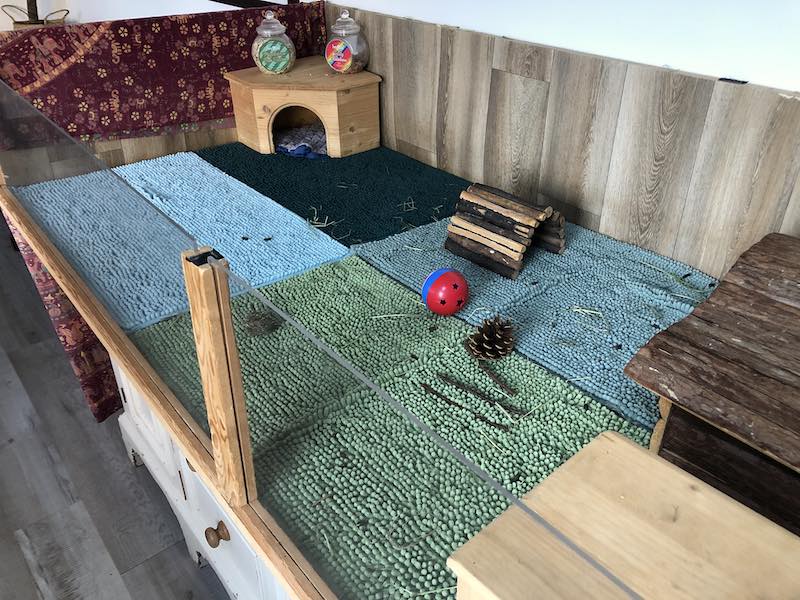
Ease of maintenance and cleaning
When planning your cage setup, it’s essential to consider the practical aspects of maintaining and cleaning the enclosure and ensuring easy access to your guinea pigs.
Think about how simple it will be to change bedding, clean feeding areas, and access hideouts for regular checks and cleaning.
The design should facilitate daily spot cleaning and more extensive weekly cleaning. Considering this when designing your layout will make maintaining hygiene levels much more manageable.
Safety considerations
Safety must be a top priority when designing your guinea pigs’ enclosure. It’s essential to carefully consider the placement of accessories to prevent any possible escapes and to ensure that all items within their reach are free from health or safety hazards.
Also, securing features such as ramps is vital to eliminate the risk of falls.
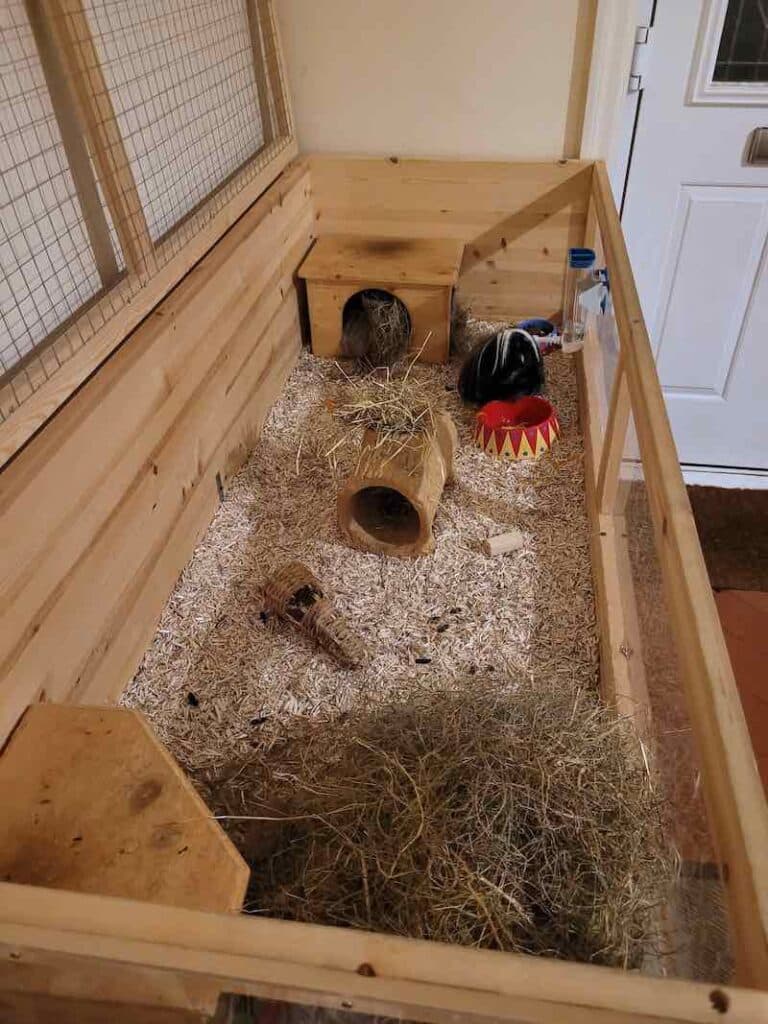
Creating a stimulating environment
Regularly changing the layout of their enclosure provides your guinea pigs with new experiences, promoting a stimulating environment. Incorporating various exciting elements into their cage benefits their well-being, as it helps prevent boredom.
Accessories like the Haypigs treat ball, especially when filled with a few , are a favourite among my guinea pigs. For more creative ideas to enhance your guinea pigs’ environment, please see our page on the best guinea pig toys.
Further information on housing a guinea pig
For further information on guinea pig housing, please take a look at the following resources:
- Guinea Pig Housing Guide
- Best Indoor Guinea Pig Cages
- Best Outdoor Guinea Pig Hutches
- How to Make a DIY Modular Cage
- How to Keep Guinea Pigs Warm in Winter
- How to Keep Guinea Pigs Cool in Hot Weather
- Runs and Pens for Guinea Pigs
- Best Guinea Pig Toys
- Best Guinea Pig Hideouts
Written by Monique, an experienced guinea pig owner with the guinea pigs’ best interests at heart. Find out more about me here.
